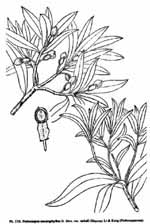 Line drawing (1). | Podocarpus nakaii Hayata 1916Common NamesNakai podocarp,Taxonomic notesSyn: P. macrophyllus var. nakaii (Hayata) Li & Keng 1954; P. macrophyllus var. maki Endlicher 1847 (1). The classification used here is that chosen by de Laubenfels (2), who regards P. macrophyllus var. maki as a synonym for P. chinensis.DescriptionA medium-sized tree, to 60 cm in diameter. Bark grayish red-brown, breaking up into longitudinal thin shaggy flakes, flakes 1-2 cm. wide, 0.5 mm. thick; lenticels inconspicuous, outer bark 2-3 mm. in thickness, fibrous, with a reddish brown cross-section; newly formed periderm pale reddish brown; inner bark 2-6 mm. thick, pale reddish orange, immediately becoming pale yellowish brown after cutting, finely fibrous; cambium and newly formed phloem white in color. Branches terete, glabrous. Leaves coriaceous, alternate, lanceolate to linear-lanceolate, 6-8 cm long, 8-12 mm broad, straight or slightly falcate, dark green above, silver-green beneath, the base cuneate, acute or shortly attenuate; petioles very short, about 5 mm long. Staminate strobilus 4-6 cm. long. Seeds solitary, axillary, obliquely ovoid, acute at the apex, 1 cm long, 8 mm wide; receptacle fleshy, pale red at maturity in April, obliquely onconical-globose, 2-lobed, 5-12 mm long; peduncles 2-12 mm long. Freshly cut sapwood pale apricot yellow, wood rays inconspicuous (1, 3).RangeTaiwan: "the northern and central parts of the island, scattered in broad-leaved forests" (1).Big TreeOldestDendrochronologyEthnobotanyObservationsRemarksCitations(1) Li 1975 (as P. macrophyllus var. nakaii).(2) P.269 of de Laubenfels 1985. (3) Liu 1970. |
[Podocarpus] [Podocarpaceae] [home] This page is from the Gymnosperm Database |